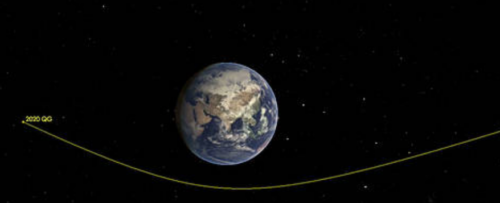UNITED STATES—An SUV-size space rock flew past the planet over the weekend. This is the closest encounter with a space object NASA and Pasadena-based Jet Propulsion Laboratory announced on Tuesday, August 18.
“It’s really cool to see a small asteroid come by this close, because we can see the Earth’s gravity dramatically bend its trajectory,” said Paul Chodas, director of the Center for Near-Earth Object Studies at JPL in a statement. “Our calculations show that this asteroid got turned by 45 degrees or so as it swung by our planet.”
Near Earth Asteroids or NEAs, pass by Earth all the time according to officials, but this asteroid set the record by coming closest to Earth than any other known NEA. It passed 1,830 miles (2,950 kilometers) above the southern Indian Ocean on August 16 around 9 p.m. PST, according to JPL.
The asteroid is small by asteroid standards officials say, it has the potential to break up in the Earth’s atmosphere on impact.
The NEA known as asteroid 2020 QG is estimated to be about 10 to 20 feet long and traveling at about eight miles per second. Due to its size and swiftness it was detected six hours after the closest point of approach when the asteroid was moving away from Earth.
“It’s quite an accomplishment to find these tiny close-in asteroids in the first place, because they pass by so fast,” said Chodas. “There’s typically only a short window of a couple of days before or after close approach when this small of an asteroid is close enough to Earth to be bright enough but not so close that it moves too fast in the sky to be detected by a telescope.”
Asteroid 2020 QG enters the record books as the closest known non-impacting asteroid. Many very small asteroids impact our planet every year, but only a few have been detected in space a few hours before impacting Earth. On average, an asteroid the size of 2020 QG passes this closely only a few times a year according to JPL officials.






